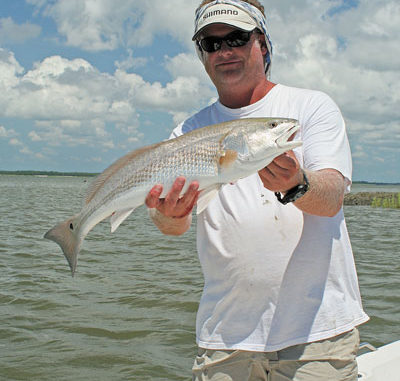
Broad River is a great place to catch the summer inshore slam: reds, specks, flounder.
Summers in the Lowcountry are plagued with biting insects, high humidity and scorching temperatures; not to mention afternoon thunderstorms that pop up out of nowhere.
No wonder the droves of fisherman who were out on the water in the spring have thinned out just to a few diehards, but many of those are enjoying the multitude of species they can catch on the same outing.
In the Broad River near Beaufort, common bottom-dwellers such as whiting, croaker and sharks can be found easily, and more exotic big game, including tarpon and jacks, start to show up as well. For some anglers, summer fishing is all about the “big three” that comprise an inshore slam: redfish, speckled trout and flounder. Using techniques learned through many hours spent in the roughshod conditions of summer, these anglers are regularly achieving what others only hope too.
Capt. Steve Roll of Seas So Shallow Guide Service thrives on the opportunity to take an inshore slam from the Broad River.
“There is nothing like watching a true Carolina sunset on the water after a slam,” he said.
Often starting out on the high tide and fishing until the low, Roll begins most hunts for a slam by catching his favorite quarry: redfish. He starts his search at home, looking over charts. He finds areas to target by searching for long stretches of water around a food deep up against the spartina grass of the marsh, close to the mouth of a feeder creek.
The next step is to look for signs of fish; water pushing or other disturbances are a sure sign that fish are there and are easy targets. As the tide starts to move out, reds will first hang on the grass edge before gathering on the mud flat in small schools containing up to a couple of dozen fish. Roll’s rig of choice is a 7-foot, medium action spinning rod outfit spooled with a braided line such as Power Pro.
“The sharp edges of spartina grass can easily damage monofilament, leading to broken off fish,” Roll said.
On the business end of his set-up, he uses a popping cork with 18 to 20 inches of fluorocarbon leader, a 1/0 circle hook and a small split shot two to three inches above the hook. Preferred baits are live shrimp, mud minnows or fresh cut mullet. Hook mud minnows through the lips, shrimp through the back of the head (avoiding the dark spots). Roll said he always uses the head of cut mullet first, hooking them through the lips just as he would a live ones.
“I think the mullet heads are more recognizable to the reds, but whatever the reason, the heads always seem to outperform any other part of the mullet,” he said.
Fulfilling the trout portion of the grand slam used to be easy, but the last two winters have decimated trout populations. According to the S.C. Department of Natural Resources, spotted seatrout numbers are at their lowest in 20 years, and anglers have been asked to voluntarily to release all they catch until September.
“I remember about three years ago, you could anchor up about 20 feet outside of any creek mouth dumping into the Broad with 100 shrimp and catch 100 trout – not so anymore,” he said. “Don’t get me wrong; they are still around. You just have to work harder to find them.”
Roll targets docks, bridges or similar structures, anchoring or drifting down with the current. A moving tide is best because the bait needs to swim with the current as naturally as possible; starting close to the structure in the shallowest water manageable and going until it reaches the deeper water and is out of the zone.
Roll uses the same tackle for trout that he does for reds, but he uses an eighth- to quarter-ounce jighead (plain, red or chartreuse), tied directly to the line and paired with a soft-plastic curlytail. Color will vary with the mood of the trout; good choices to have on hand are electric chicken, white, chartreuse and root beer. Of course, a live shrimp under a Cajun Thunder rattling cork is always an option when the trout are acting finicky.
Once two-thirds of the slam is complete, Roll advances to the final and tastiest part of the equation: the flounder. As the Broad River heats up during the summer, flounder will move into smaller creeks and stay until it cools down in the fall. Naturally, they will be more concentrated and easier to find at or near the low tide. Anywhere in small creeks can be good places to target them, but especially productive area ditches draining into them from the marsh.
A Carolina rig with an 18-inch leader and a few beads clacking together between a quarter-ounce barrel or bullet weight and the swivel is particularly effective for getting a flounder’s attention.
“Flounder do not get spooked very easily, and there are many good techniques for catching them,” Roll said. “Artificial and live bait can both work wonders, as well as colored spinners.”
Placing bait on the bottom during the summer, especially natural bait, is bound to yield a few unwelcome catches, including skates and small sharks. If this happens too often, switching to artificial lures or keeping the bait in motion will be the best options for weeding out the undesirables.
Many fishermen who frequently target shallow-water species have discovered the benefits of shallow-water anchors such as the Power Pole. A shallow-water anchor allows anglers to quickly position and repositions their boats as water levels change and fish move. When used in combination with an electric trolling motor built to stand up to the saltwater, the results are astounding; anglers easily move with the tide and the fish, maximizing productive time on the water.
Obviously, timing is a big factor when going after a summer slam. There are times when a fisherman will have to leave one species to pursue the next on the list. This is easier said than done, but a good game plan is often the difference between success and failure.
Fishermen determined to catch a slam will study the locations and tides, and determine the best time for each species before ever backing his boat down the ramp, and then execute the plan on the water.
Fishermen with a solid game plan and a little resolve and desire for great summertime action can consistently achieve one of the ultimate angling experiences, even on the doggiest of days.

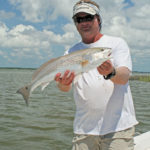
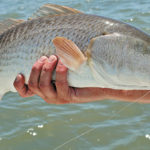
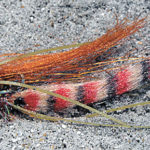
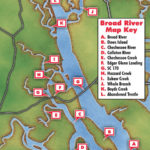
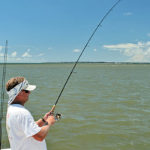
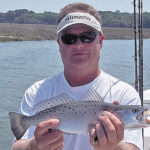
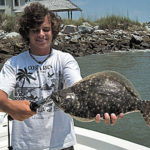



Be the first to comment